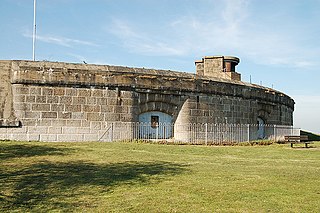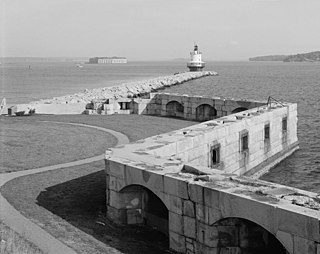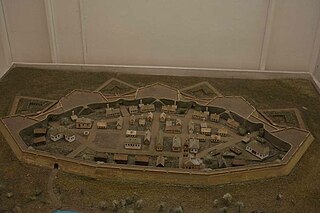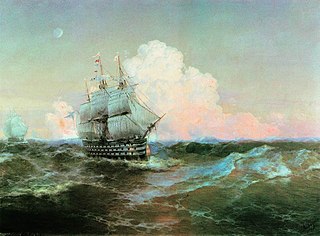
The Crimean War was fought from October 1853 to February 1856 between the Russian Empire and an ultimately victorious alliance of the Ottoman Empire, France, the United Kingdom, and Sardinia-Piedmont.

Fort Wool is a decommissioned island fortification located in the mouth of Hampton Roads, adjacent to the Hampton Roads Bridge-Tunnel (HRBT). Officially known as Rip Raps Island, the fort has an elevation of 7 feet and sits near Old Point Comfort, Old Point Comfort Light, Willoughby Beach and Willoughby Spit, approximately one mile south of Fort Monroe.

Coalhouse Fort is an artillery fort in the eastern English county of Essex. It was built in the 1860s to guard the lower Thames from seaborne attack. It stands at Coalhouse Point on the north bank of the river, at a location near East Tilbury which was vulnerable to raiders and invaders. It was the last in a series of fortifications dating back to the 15th century and was the direct successor to a smaller mid-19th century fort built on the same site. Constructed during a period of tension with France, its location on marshy ground caused problems from the start and led to a lengthy construction process. The fort was equipped with a variety of large-calibre artillery guns and the most modern defensive facilities of the time, including shell-proof casemates protected by granite facing and cast-iron shields. Its lengthy construction and the rapid pace of artillery development at the time meant that it was practically obsolete for its original purpose within a few years of its completion.

Barbettes are several types of gun emplacement in terrestrial fortifications or on naval ships.

The Royal Commission on the Defence of the United Kingdom was a committee formed in 1859 to enquire into the ability of the United Kingdom to defend itself against an attempted invasion by a foreign power, and to advise the British Government on the remedial action required. The appointment of the Commission had been prompted by public concern about the growing military and naval power of the French Empire and was instigated by the Prime Minister, Henry Temple, 3rd Viscount Palmerston, who came to be closely associated with the project. In the following year, the Commission's report recommended a huge programme of fortification to defend the country's arsenals and naval bases. Many of the recommendations were acted upon; however, the great expense, the length of time taken to complete the various works and their perceived usefulness were all subjects of critical political, press and public debate.

A casemate is a fortified gun emplacement or armored structure from which guns are fired, in a fortification, warship, or armoured fighting vehicle.

The siege of Sevastopol lasted from October 1854 until September 1855, during the Crimean War. The allies landed at Eupatoria on 14 September 1854, intending to make a triumphal march to Sevastopol, the capital of the Crimea, with 50,000 men. Major battles along the way were Alma, Balaklava, Inkerman, Tchernaya, Redan, and, finally, Malakoff. During the siege, the allied navy undertook six bombardments of the capital, on 17 October 1854; and on 9 April, 6 June, 17 June, 17 August, and 5 September 1855.

The Dardanelles operation was a failed assault by the British Royal Navy against the coastal fortifications of Constantinople. The operation was part of the Anglo-Turkish War.

House Island is a private island in Portland Harbor in Casco Bay, Maine, United States. It is part of the City of Portland. The island is accessible only by boat. Public access is prohibited, except for an on-request tour sanctioned by the island's owners. House Island includes three buildings on the east side and Fort Scammell on the west side. The buildings are used as vacation rentals and other summer residences. The island's name derives from the site of an early European house, believed that built by Capt. Christopher Levett, an English explorer of the region.

Fort Preble was a military fort in South Portland, Maine, United States, built in 1808 and progressively added to through 1906. The fort was active during all major wars from the War of 1812 through World War II. The fort was deactivated in 1950. It is now on the campus of Southern Maine Community College.

The siege of Izmail or Ismail / Ishmael / İzmail, also called the storming of Izmail, was a military action fought in 1790 on the Black Sea during the Russo-Turkish War (1787–1792) and simultaneously the Austro-Turkish War (1788–91). The Russians were led by Alexander Suvorov, who had defeated the Ottomans at Kinburn, Focsani, and Rymnik, as well as participating in the siege of Ochakov. The Black Sea rowing flotilla was commanded by the Spanish admiral José de Ribas.

The Battle of Kinburn, a combined land-naval engagement during the final stage of the Crimean War, took place on the tip of the Kinburn Peninsula on 17 October 1855. During the battle a combined fleet of vessels from the French Navy and the British Royal Navy bombarded Russian coastal fortifications after an Anglo-French ground force had besieged them. Three French ironclad batteries carried out the main attack, which saw the main Russian fortress destroyed in an action that lasted about three hours.

The Juma-Jami Mosque, also known as the Friday Mosque, is located in Yevpatoria, Crimea. Built between 1552 and 1564, and designed by the Ottoman architect Mimar Sinan.

Vladivostok Fortress is a system of fortifications built from 1889 to 1918 in Vladivostok, Russia, and the surrounding area.

Taganrog Fortress was a star fort-style fortress built during the reign of Peter the Great and re-constructed by the order of Catherine the Great.

François-Paul Sainte de Wollant was a Flemish engineer. He is best known for a number of fortifications in Imperial Russia which were built under his supervision, such as a now-lost 1794 battery on the site of the later Konstantin Battery in Sevastopol. In Tiraspol, Transnistria, a park is named after him.

Apart from a Roman Fort, there were very few fortifications in Alderney until the mid 19th century. These were then modified and updated in the mid 20th Century by Germans during the occupation period. Alderney at 8 km2 is now one of the most fortified places in the world.

St. George's Castle is an Ottoman fortification located in the city of Preveza, northwestern Greece. It was built in 1807, during the rule of Ali Pasha of Ioannina over the region (1806-1820), and it was constructed on plans drawn by the French engineer Frédéric François Guillaume de Vaudoncourt (1772-1845).
Fort Constantine, Fort Konstantin, Fort Constantin, or Fort Grand Duke Constantine may refer to:

The Russian ship Dvienadsat Apostolov was the lead ship of her class of three first rate ship of the line built for the Imperial Russian Navy. Completed in 1842, she served her whole career with the Black Sea Fleet. Dvienadsat Apostolov took part in the defence of Sevastopol during the Crimean War. Rather than facing the powerful Anglo-French fleet, her guns were landed to reinforce the landward fortifications and she was used as a hospital ship. On the night of 25/26 February 1854, she was one of the Russian ships that was sunk as a blockship in the northern bay of Sevastopol.



















